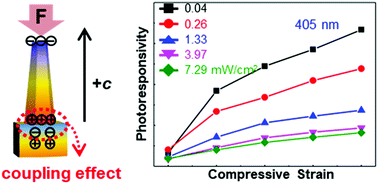Rationally designed piezoelectric charge polarity at interfaces for largely improving photodiode performance by piezo-phototronic effects†
Abstract
The piezo-phototronic effect is a three-way coupling effect among optical, electrical and mechanical properties of piezoelectric semiconductor (piezo-semi) materials. Although both positive and negative piezoelectric charges (piezo-charges) appear at either end of the piezo-semi material when it is stretched or compressed along a certain direction, only one type/polarity of piezo-charges is investigated and only a single layer of the piezo-semi material is utilized in many of the relevant studies. In this work, not only significant photoresponse improvements by the piezo-phototronic effect are experimentally achieved, but also the coupling effects of positive and negative piezo-charges at the collective interface of two piezo-semi materials are systematically studied. The promising results indicate that: (1) the net quantity and the polarity of piezo-charges can be rationally designed by carefully choosing the neighboring piezo-semi materials, and (2) the multi-layer device structure is a very feasible method to achieve high photoresponse performances especially with the help of the piezo-phototronic effect.

- This article is part of the themed collection: Journal of Materials Chemistry C HOT Papers


 Please wait while we load your content...
Please wait while we load your content...